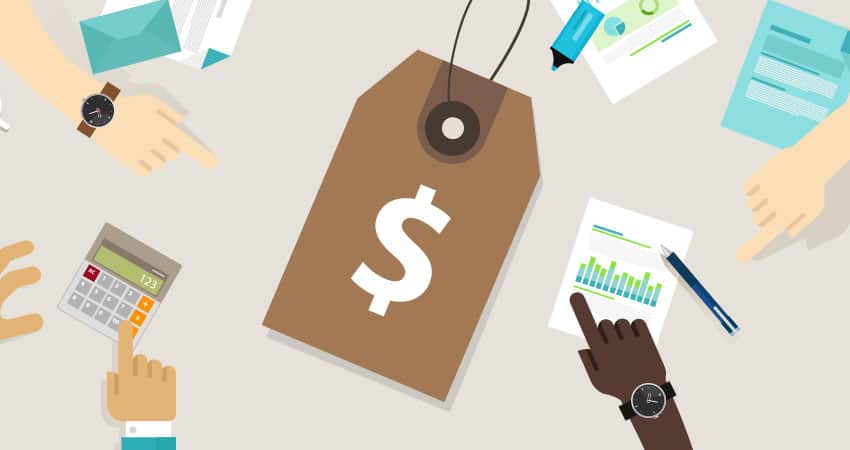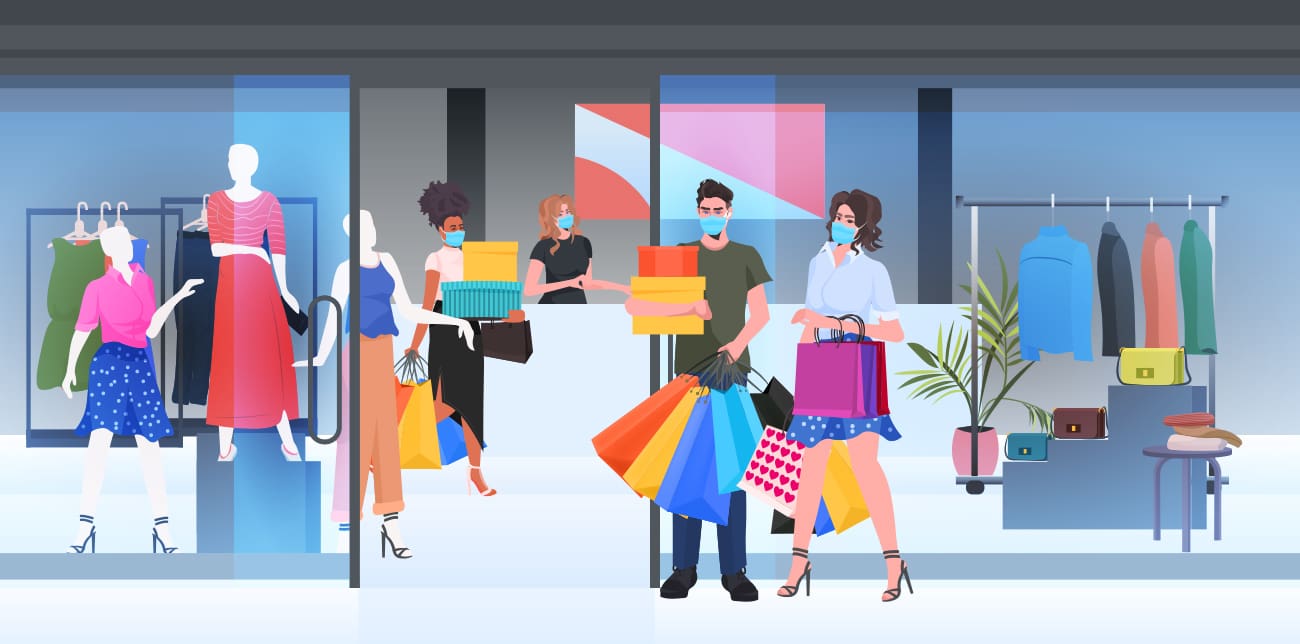Providing an assistive customer journey and foretelling customer needs is a catalyst for exponential growth, as 89% of profitable companies say. To thrive in retail, you must continually improve customer touchpoints throughout the purchase journey to earn and keep loyal customers. Building on customer experience best practices will fortify the customer journey and refine your overall customer experience quality.
Considering that 73% of customers prioritize customer experience over price and product quality when making a purchase decision, it’s clear that a successful customer experience is the lifeline of retail brands. To keep turning profits, you need to implement and maintain a solid customer experience based on the latest eCommerce and retail best practices. But before we get into the specifics, let’s first define the retail customer experience and explore how the pandemic has transformed it as a whole.
Table of Contents
What is retail customer experience?
Retail customer experience is the perception of an event, or episode, referring to the overarching feeling customers experience when interacting with your brand online and in-store. It’s an encounter that creates and leaves a specific impression of your brand’s image in your customer’s mind.
The experience begins from the initial touchpoint when a customer visits your website or store and extends to the final purchase and post-purchase touchpoints. Good retail customer experience enhances customer satisfaction and earns you loyal customers who share your brand with others. It’s estimated that happy customers tell an average of nine people about an excellent retail experience. Hence, upholding best practices for customer experience will help you build your brand.
How COVID-19 affected customer experience
The pandemic has forced retailers to redefine customer experience and customer engagement in the wake of new customer behaviors and preferences. In the post-COVID-19 era, customers regard safety, care, and empathy as the bedrock of customer experience. These stats tell it all:
- 95% of consumers maintain that companies should apply distancing measures to protect their health.
- 71% of customers will stop trusting a brand forever if they perceive the company is putting profits over consumers.
- 52% of consumers say brands can show empathy by treating people with respect.
- 84.5% of shoppers have said that they’re at least somewhat concerned about contracting Covid-19 at the grocery store
Today more than ever, customers are yearning for brands that will bridge the emotional disconnect created by the pandemic without endangering their health. This is why you must adopt new customer experience strategy best practices that address the latest customer needs and wants in the post-pandemic era.
20 customer experience best practices for retailers to thrive in 2021
Marketers worldwide agree that a good deal of the new consumer behaviors brought about by the pandemic will be permanent. For instance, 56% of consumers who adopted the BOPIS (buy online, pick up in-store) model intend to continue using the model even after the pandemic. These best customer experience practices are here to conquer retail in 2021 and set the standards for the upcoming years.
Customer experience best practice #1: Design genuinely unique brand experiences

In the post-pandemic era, you’ll have to get out of your comfort zone and bring your A-game into the virtual world. Think of innovative virtual marketing strategies that not only create hype around your brand but also drive sales. So far, visionary brands that have implemented out-of-the-box online marketing strategies are already enjoying success.
Design some fun never-done-before virtual challenges for your customers and introduce creative ideas that’ll keep your customers hooked to your brand and your products. A good virtual marketing strategy should factor in customer emotions to remain relevant and captivating.
Key question for your brand: Do we offer a remarkably better customer experience vs. our competitors?
Customer experience best practice #2: Provide true value from the use of your products
True product value is measured by how well your product addresses your customers’ needs. Consumers have a set of goals they seek to achieve from utilizing your product. If your product doesn’t solve their pain points, they’ll perceive it to be of less value.
Additionally, you should know your product’s true value and perceived value. If there’s a disconnect in your marketing strategies, you may have a great product with a high perceived value but falls short in true value. This may happen either because your brand’s message is not connecting with your customers, or you’re not clear what your brand message is. In such a case, you should put your product through a true value test to get to the bottom-line issues impeding your product’s growth.
Key question for your brand: Do our products meet our customers’ needs?
Customer experience best practice #3: Continuously track, analyze & optimize every customer journey touchpoint

You must understand your customers’ complete buying journey so you can optimize and improve touchpoints. Each phase of a customer’s journey — awareness, consideration, and post-purchase — utilizes specific touchpoints as listed below:
- Awareness touchpoints include website, live chat, chatbots, social media, customer reviews, online advertisement, and events
- Evaluation touchpoints include product demos, phone calls, product catalog, and email inquiries.
- Post-purchase touchpoints include newsletter, feedback survey, customer loyalty programs, order tracking, delivery confirmation, and email follow-ups
- In-store touchpoints refer to the interactions a customer has when visiting a physical retail store. It includes pretty much everything in the store; from the signage, the greeting of the receptionist, the price tags, to the tone of voice of the staff.
Tracking and reviewing each touchpoint monthly will identify gaps that undermine customer engagement and customer delight. To make the process even more efficient, consider automating your entire marketing campaign and make sure to monitor your customer behavior across each channel.
Key question for your brand: Do we track and analyze every customer touchpoint?
Customer experience best practice #4: Optimize the digital customer experience

According to 69% of marketers, COVID-19 has made the digital customer experience more essential to their customers. Thus, you must invest more time and resources to make digital shopping effortless for your online consumers. With robust technology at your disposal, you should double down on digital CX to design and deliver exceptional personalized customer experiences to outclass your competitors.
Start by optimizing all your omnichannel platforms, especially your website and mobile app to ensure customers have a great eCommerce shopping experience. Upgrading your web’s UX design makes it easy for shoppers to navigate easily in your online store using a phone or desktop. Most customers will click out of your website if it has a complicated user experience interface. Hence, your eCommerce website and app must have a user-friendly design.
Furthermore, you should ensure your eCommerce platforms have updated security features to deter online fraud. Modern customers are more protective of their personal and financial data and want assurance that their information is secured when shopping online. Lastly, certify that the delivery timeline promised on your eCommerce platform matches the actual ground delivery timeframes. Additionally, ensure that the products delivered appear as promised on your eCommerce platform. This will help fortify customers’ trust in your brand.
Key question for your brand: How can we offer a remarkably better customer experience than our competitors?
Customer experience best practice #5: Differentiate at every opportunity
Rarely will you edge out competition from a point-of-parity (POP); it’s differentiation that carries the day. Differentiation is a brand’s point of difference (PoD) along with the points of inferiority (PoI) and how they are measured in comparison with the competition. The spine of differentiation is again the customer journey, which must be as smooth as possible for the consumer. To differentiate, you must align your brand purpose with the customer journey.
Ideally, your product should leverage any of the following differentiation points:
- Quality
- Pricing
- Innovation
- Performance
- Availability
- Customization and packaging
A perfect example of a remarkable brand differentiation case could be the example of Zappos, which steadily became famous for its stellar customer support culture.
Key question for your brand: What kind of differentiation does my product have?
Customer experience best practice #6: Monitor and be aware of your pricing strategy

The pandemic has curtailed the financial power of many consumers. 27% are saving beyond their usual limit, and 26% plan to increase their savings in the future. For these reasons, the overall consumer buying power has been reduced. Therefore, your pricing strategy should strive to entice consumers who are inclined to second guess any non-essential purchase. To make considerable headway, think of pricing as a differentiating factor.
Customers are now more receptive to value-based pricing strategies than they were before. This means your pricing must match the value of your end products. If customers pay more for a product but find the product’s quality lacking, they’ll have a negative perception of your brand. Conversely, if they pay more and get superior quality, they’ll hold your brand in high regard. If you get your pricing right, sell products of the finest quality, and offer great customer service, you’ll create an excellent customer experience for all shoppers.
Key question for your brand: Is the price aligned with the value of your product? (offered packaging, product performance & after-sales experience – usually premium or luxury products)
Customer experience best practice #7: Offer the most unified shopping experience possible
Unifying your customers under one platform is vital because it centralizes communication and helps you scale customer experience across the board. Using the omnichannel approach will help you deliver a consistent shopping experience across all the digital platforms your shoppers use.
If you want a next-level omnichannel experience, utilize unified commerce. A unified commerce platform will integrate all your marketing and customer service systems on one platform without creating data silos.
Key question for your brand: What’s the best way to unify the shopping experience?
Customer experience best practice #8: Strengthen your customer loyalty strategy
Today, it pays to measure behavioral loyalty alongside emotional loyalty to get an accurate picture of how customers perceive your brand. That’s why 83% of brands are boosting their investment in loyalty by 5%. To make the best of your loyalty program, you must be innovative and offer deals that add value to customers, increase customer engagement, and boost conversions.
A great loyalty program will boost your customer lifetime value (CLV) and brand loyalty significantly. As a retailer, a loyal customer is your most prized asset, and you should ensure your loyalty program shows them how much you value their business.
Key question for your brand: How can I revitalize my brand’s loyalty program?
Customer experience best practice #9: Focus on contactless and effortless checkout experiences (in-store & online)

Contactless checkout was on the rise even before the pandemic. Now, 90% of customers expect retailers to have self-checkout machines. If your store receives a lot of foot traffic, self-service should be your top priority. With effortless checkout, shoppers won’t have to wait in line and possibly violate social distancing regulations. This will enhance health safety for both customers and employees. Besides upholding customer safety, effortless checkout boosts the overall buying experience because customers can transact fast and safely using their mobile phones or credit cards.
Key question for your brand: How will contactless checkout boost customer safety and buying experience?
Customer experience best practice #10: Localize and focus on your customer segment
The pandemic has influenced consumer behavior profoundly, segmenting customer priorities further. Post pandemic, 32% of customers are prioritizing affordability, while 25% are putting health first. This means you must localize your market research to know your customer segment so your customer experience strategies can be on point.
A good place to start is developing an effective buyer persona. A successful buyer persona will inform and guide you to segment marketing campaigns precisely, so you can avoid targeting the wrong audience. This will aid you in defining your marketing and CX strategies in the long term, making them more targeted and personalized.
Key questions for your brand: Can we reliably describe a typical day of our target customer?
Customer experience best practice #11: Predict and solve your customers’ problems
Modern consumers expect brands to presage future problems and design solutions in advance. Luckily, you can use predictive analytic tools that leverage AI and machine learning. By analyzing consumer data extensively, you can derive predictive insights and anticipate CX issues. The trick here is adopting and maintaining a proactive stance. With this mindset, you’ll make better use of predictive analytics AI and develop helpful suggestions and solutions to predate possible CX issues.
Key question for your brand: What problems are likely to affect my products in the future?
Customer experience best practice #12: Tune in to your customers’ values
Consumer awareness and activism have impacted buying behavior significantly. Today’s customers are well informed and actively churn brands with unethical sourcing, bad employee treatment, and discriminating or poor sustainability practices. Brands that consumers perceive as apathetic to the social ills affecting them are also facing customer backlash.
Hence, it’s crucial to have a well-balanced brand activism strategy that stands behind your customers’ values. If not, you’ll risk being on the receiving end of cancel culture, putting your brand’s reputation on the line.
Key question for your brand: How can ethical issues affect my brand?
Customer experience best practice #13: Invest in reskilling your team

Adapting to the new normal in the post-pandemic era requires a unique set of digital and personal skills. This calls for a progressive learning-and-development (L&D) strategy to train all your employees on an as-needed basis. Presently, most companies are investing in empathy training to equip their teams with new skills to deal with anxiety-ridden customers. Furthermore, assessing the effectiveness of a team and its quality of service needs tracking and monitoring. Scheduling additional seminars, coaching sessions, and group exercises can aid in your personnel’s development and growth.
Key question for your brand: What new skills do employees need post-COVID-19?
Customer experience best practice #14: Normalize follow-ups
Post-purchase experiences are as vital to customers as the purchase and pre-purchase experiences. A good after-sales experience boosts your customer retention rate and increases loyalty among first-time clients. Having a solid follow-up strategy will refine your post-purchase experience.
Key question for your brand: Is my follow-up strategy personal?
Customer experience best practice #15: Seek fresh feedback data

Relying on feedback data collected before the pandemic can skew your CX strategies as consumer behavior has since changed. Therefore, you should consider restructuring your feedback loop accordingly, by gathering new information from customers, analyzing data, and applying the outcomes to your product. Updating your feedback loop will give your brand an advantage over the competition, and leave a memorable impression to your customers with a high-quality digital journey.
Key question for your brand: How do I read new consumer behavior effectively?
Customer experience best practice #16: Embrace agility in marketing
The pandemic unveiled what most marketers have been echoing for years — CX is a never-ending continuum that requires progressive fine-tuning to make it work. At the onset of the pandemic, many offline marketing strategies were rendered redundant due to the lockdowns. Retailers that were lagging in online marketing struggled to catch up, and some went under.
With the looming uncertainties in the post COVID era, you must reimagine your marketing plans and make them agile and accommodative. This way, you’ll have enough elbow room to reposition your marketing plans in case another crisis strikes.
Key question for your brand: Can we adjust our marketing plans in a crisis swiftly?
Customer experience best practice #17: Manage market panic without shifting focus from consumers
Retailers enjoying post-pandemic success didn’t get their eyes off their customers during the crisis. With major retailers such as J.C. Penney, Neiman Marcus, and Toys R Us filing for bankruptcy at the peak of the pandemic in 2020, it’s understandable why many retailers went into panic mode. However, the best practice in a crisis is to focus on your customers and find ways to alleviate their worry.
Key question for your brand: How do I keep my CX strategies intact during a crisis?
Customer experience best practice #18: Align your business and brand strategy with CX strategy
Understand and focus on the implications of your business and brand strategies — and how that informs the experiences your customers expect. By identifying unmet customer wants and needs in this context, you’ll be able to deliver on the promises your brand makes and the expectations set as a result.
Key question for your brand: Do my brand strategies match customer expectations?
Customer experience best practice #19: Elevate in-store experiences

While eCommerce is the future of retail, it doesn’t mean in-store shopping is dead. About 27% of consumers prefer in-person shopping. Therefore, you must redesign your stores to guarantee health safety for the consumers who shop in person. Fulfilling best practices such as social distancing, contactless payment, and maintaining hygiene will improve the in-store shopping experience. Additionally, integrating innovative retail technologies (e.g. next-gen QR codes) could skyrocket the in-store customer experience as well.
Key question for your brand: How can I improve the in-store shopping experience?
Customer experience best practice #20: Empathize and show customers genuine care

Even in the face of a pandemic, sticking to basic customer experience best practices — care and communication — will get you good results. Empathetic communication in the post-COVID-19 era will help you touch base with your customers. You can share helpful content or organize events to support customers as they transition to the new normal.
Key question for your brand: How can I show my customers care?
Customer experience best practices for B2Bs
B2B customer experience best practices are sophisticated and call for niche expertise to execute flawlessly. Even so, these five practices will help you excel in the B2B space.
Know your B2B customers inside-out
To deliver a quality customer experience to your B2B buyers, you must know their needs, challenges, and goals comprehensively. Your product must offer real-time solutions and demonstrate a clear path of increasing your customer’s revenue and efficiency.
Have an assigned account manager for key B2B clients
Big B2B customers are demanding and require customized solutions promptly. To ensure CX success, you should have a single point of contact — an account manager dedicated to the client. This will increase customer satisfaction because the account manager will deliver personalized experiences.
Offer special privileges to your VIP clients
You should go out of your way to keep your most loyal customers satisfied. You can do this by customizing your loyalty program to suit your VIP clients. For instance, you can create a digital loyalty app for your VIP clients only, or offer them skip-the-queue privileges if they sometimes shop in-store.
Educate B2B decision-makers to make an informed purchase
B2B decision-makers consider various metrics before making a buying decision. Before purchasing products, 82% of B2B customers read at least five pieces of content from the seller. During the purchasing process, 50% of all B2B buyers review at least eight articles. Hence, B2B buyers are more willing to engage a seller who offers specific industry-based insights. These consumers want an expert who will be their go-to source for reliable and actionable information.
Consider bulk pricing
During a crisis, companies often limit their spending and keep it at the minimum. It takes incentivized selling techniques like bulk pricing to make companies increase their spending. You’ll want to use an effective B2B dynamic pricing strategy to offer B2B buyers competitive prices in the post-pandemic era. Consider using statistical clustering techniques or a value-pricing approach.
Offer hands-on post-purchase support
B2B buyers require proactive after-sales support. For B2B customers, downtimes caused by product failures translate to lost revenues. That’s why businesses prioritize sellers who can deliver post-purchase support like troubleshooting assistance within a short turnaround time. Plus, providing reliable post-purchase support puts you in a better position to upsell.
Crafting the perfect customer experience
The implementation of customer experience best practices, or lack thereof, will define how customers judge and view your brand before and after purchase; it is often the differentiating factor in the cut-throat retail industry. Experiences are created by a variety of stimulations and you must use every medium available to communicate with your customers to manufacture the perfect customer experience. To do this successfully, you need a reliable customer engagement platform like ContactPigeon.
Our award-winning omnichannel customer engagement platform can help you implement the above-mentioned best practices. ContactPigeon’s platform is specifically designed for the retail sector and will allow you to craft the perfect digital and in-store customer experience for your B2C and B2B customers. We aim to help your business conquer retail as we do with all those brands that trust us with their omnichannel customer engagement strategies. Book a free 30-minute customer engagement consultation today so that we can help you create the best omnichannel customer experience strategy.




![Benchmarking Growth Strategies of Top Fashion Retailers [Study]](https://blog.contactpigeon.com/wp-content/uploads/2025/11/top-fashion-retailers.jpg)